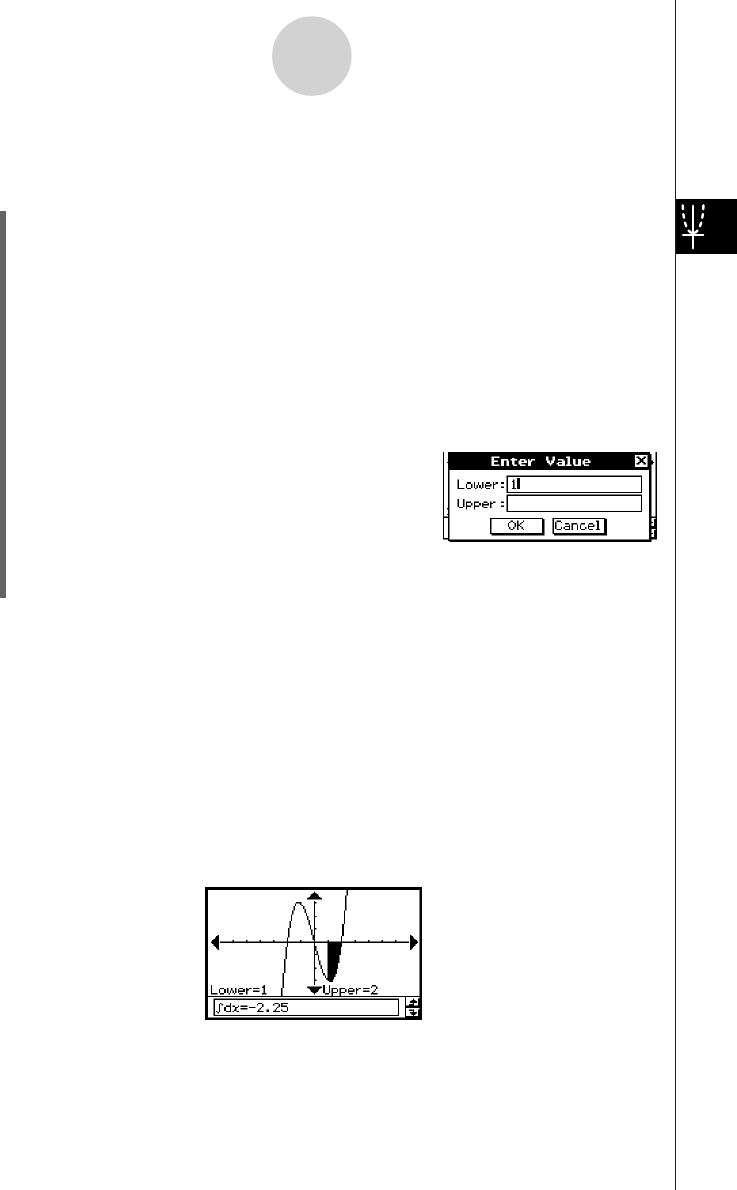User Manual
Table Of Contents
- Getting Ready
- Contents
- About This User’s Guide
- Chapter 1 Getting Acquainted
- Chapter 2 Using the Main Application
- 2-1 Main Application Overview
- 2-2 Basic Calculations
- 2-3 Using the Calculation History
- 2-4 Function Calculations
- 2-5 List Calculations
- 2-6 Matrix and Vector Calculations
- 2-7 Using the Action Menu
- 2-8 Using the Interactive Menu
- 2-9 Using the Main Application in Combination with Other Applications
- 2-10 Using Verify
- Chapter 3 Using the Graph & Table Application
- Chapter 4 Using the Conics Application
- Chapter 5 Using the 3D Graph Application
- Chapter 6 Using the Sequence Application
- Chapter 7 Using the Statistics Application
- 7-1 Statistics Application Overview
- 7-2 Using List Editor
- 7-3 Before Trying to Draw a Statistical Graph
- 7-4 Graphing Single-Variable Statistical Data
- 7-5 Graphing Paired-Variable Statistical Data
- 7-6 Using the Statistical Graph Window Toolbar
- 7-7 Performing Statistical Calculations
- 7-8 Test, Confidence Interval, and Distribution Calculations
- 7-9 Tests
- 7-10 Confidence Intervals
- 7-11 Distribution
- 7-12 Statistical System Variables
- Chapter 8 Using the Geometry Application
- Chapter 9 Using the Numeric Solver Application
- Chapter 10 Using the eActivity Application
- Chapter 11 Using the Presentation Application
- Chapter 12 Using the Program Application
- Chapter 13 Using the Spreadsheet Application
- Chapter 14 Using the Setup Menu
- Chapter 15 Configuring System Settings
- 15-1 System Setting Overview
- 15-2 Managing Memory Usage
- 15-3 Using the Reset Dialog Box
- 15-4 Initializing Your ClassPad
- 15-5 Adjusting Display Contrast
- 15-6 Configuring Power Properties
- 15-7 Specifying the Display Language
- 15-8 Specifying the Font Set
- 15-9 Specifying the Alphabetic Keyboard Arrangement
- 15-10 Optimizing “Flash ROM”
- 15-11 Specifying the Ending Screen Image
- 15-12 Adjusting Touch Panel Alignment
- 15-13 Viewing Version Information
- Chapter 16 Performing Data Communication
- Appendix

20050501
u To determine the definite integral for a particular domain
Example: To graph the function y = x(x + 2)(x – 2) and obtain its definite integral in the
domain of 1 < x < 2
(1) Display the View Window dialog box, and then configure it with the following
parameters.
xmin = –7.7, xmax = 7.7, xscale = 1
ymin = –4, ymax = 4, yscale = 1
(2) On the Graph Editor window, input and store y = x(x + 2)(x – 2) into line y1, and then
tap $ to graph it.
•Make sure that only y1 is checked.
(3) Tap [Analysis], [G-Solve], and then [
∫
dx].
• This displays “Lower” on the Graph window.
(4) Press 1.
• This displays a dialog box for inputting an interval for
the x-values, with 1 specified for the lower limit of the
x-axis (Lower).
3-8-6
Analyzing a Function Used to Draw a Graph
(5) Tap the [Upper] input box and then input 2 for the upper limit of the x-axis.
(6) Tap [OK].
Tip
• Instead of inputting [Lower] and [Upper] values in steps (4) through (6), you can use the cursor
key or the graph controller arrows to move the pointer along the graph to specify the lower limit
and upper limit. If you do, perform the following two steps after step (3).
(4) Use the cursor key or the graph controller to move the pointer to the location of the lower limit
and then press E.
• This registers the lower limit and changes the word in the lower right corner of the Graph
window to “Upper”.
(5) Move the pointer to the location of the upper limit, and then press E.
Result Screenshot










